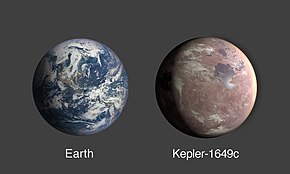 Size comparison of Earth and Kepler-1649c (artist's impression) | |
| Discovery | |
|---|---|
| Discovered by | Kepler spacecraft |
| Discovery date | 15 April 2020 |
| Transit | |
| Orbital characteristics | |
| 0.0649[1] AU | |
| 19.5352551±0.0001018[1] d | |
| Inclination | 89.65 |
| Star | Kepler-1649 |
| Physical characteristics | |
| 1.06+0.15 −0.10 R🜨 | |
| Mass | 1.2[2] ME |
Mean density | 5.54 g/cm3 |
| Temperature | Teq: 234 K (−39 °C; −38 °F) |
Kepler-1649c is an Earth-sized exoplanet, likely rocky, orbiting within the habitable zone of the red dwarf star Kepler-1649, the outermost planet of the planetary system discovered by Kepler’s space telescope. It is located about 301 light-years (92 pc) away from Earth, in the constellation of Cygnus.[3]
Kepler-1649c orbits its star a distance of 0.0649 AU (9.71 million km; 6.03 million mi) from its host star with an orbital period of roughly 19.53 days, has a mass 1.2x times that of Earth, and has a radius of around 1.02 times that of Earth. Based on its mass and radius, it is likely a terrestrial planet, though its proximity to its star means it may likely be tidally locked. Kepler-1649c is estimated to receive about three-quarters of radiation from its host star as Earth does from the Sun.
In 2017, Jeff Coughlin, the director of SETI's K2 Science Office, described it as the most "similar planet to Earth" found so far by the Kepler Space Telescope.[4] The planet was initially deemed a false positive by Kepler's robovetter algorithm. The Kepler False Positive Working Group published its recovery on April 15, 2020.[5][6] Its first scientific description was published in The Astrophysical Journal Letters, with first author Andrew Vanderburg, in April 2020.[5][7]
- ^ a b "NASA Exoplanet Archive – Planet Candidate Overview – Kepler-1649c". Retrieved 27 April 2020.
- ^ "ExoplanetKyoto - Kepler 1649c". www.exoplanetkyoto.com. Retrieved 1 May 2020.
- ^ April 2020, Mike Wall 15 (15 April 2020). "Newfound alien planet may be most Earth-like yet". Space.com. Retrieved 2020-04-16.
{{cite web}}: CS1 maint: numeric names: authors list (link) - ^ Georgiou, Aristos (16 April 2020). "Potentially habitable exoplanet that is Earth-like in size and temperature was discovered 300 light-years away". Newsweek. Retrieved 17 April 2020.
- ^ a b Vanderburg, Andrew; Rowden, Pamela; Bryson, Steve; Coughlin, Jeffrey; Batalha, Natalie; Collins, Karen A.; Latham, David W.; Mullally, Susan E.; Colón, Knicole D.; Henze, Chris; Huang, Chelsea X. (2020-04-15). "A Habitable-zone Earth-sized Planet Rescued from False Positive Status". The Astrophysical Journal. 893 (1): L27. arXiv:2004.06725. Bibcode:2020ApJ...893L..27V. doi:10.3847/2041-8213/ab84e5. ISSN 2041-8213. S2CID 215768850.
- ^ Strickland, Ashley (15 April 2020). "New potentially habitable exoplanet is similar in size and temperature to Earth". CNN. Retrieved 17 April 2020.
The study published Wednesday in The Astrophysical Journal Letters.
- ^ "Texas-Led Team Finds Earth-Sized, Habitable Zone Planet Hidden in Early NASA Kepler Data". University of Texas at Austin. Archived from the original on 2021-12-18. Retrieved 2020-05-18.